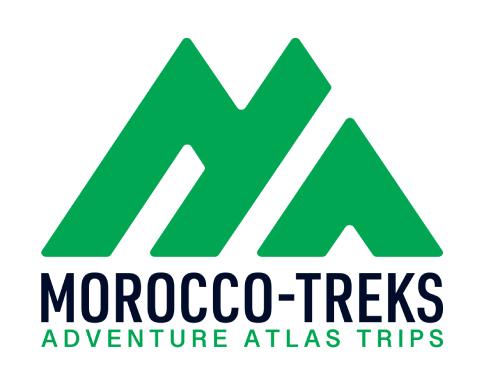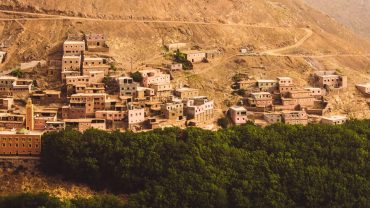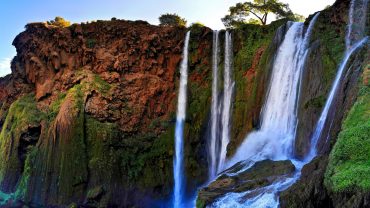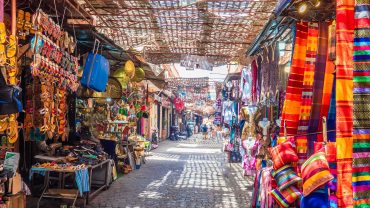When I first gazed up at Mount Toubkal from Marrakech, I knew this adventure was calling my name. Standing proudly at 4167 meters, Toubkal isn’t just another mountain—it’s the highest peak in North Africa, a dream that had been tugging at my heart for years. This Mount Toubkal climb was something I had been planning for months, but no amount of preparation could fully ready me for what lay ahead.
My journey began in darkness, well before dawn, with cold air filling my lungs and excitement pumping through my veins. Step by step, we discovered an unfamiliar path as the temperature dropped and the sunrise pulled us forward. This is my story of conquering the mighty Toubkal—a test of endurance, cold, hunger, and determination that would push me to my limits and reward me with views that few get to experience.
Getting to the Starting Point: Imlil Village
Our adventure started in Marrakech, where we gathered our team and supplies. From there, we drove to Imlil, a small Berber village nestled at the foot of the Atlas Mountains at around 1,800 meters above sea level. This charming settlement serves as the gateway to Toubkal National Park and the traditional starting point for most trekkers.
“We’ve arrived at Imlil, a village below Toubkal. We’ll leave our cars here and start the climb toward the refuge,” I told my friends as we surveyed the surrounding peaks.
The drive from Marrakech to Imlil takes about 1.5 hours, winding through beautiful scenery that transitions from urban bustle to mountain tranquility. If you’re planning your own trip, I recommend either hiring a private driver (more expensive but convenient) or taking a shared “grand taxi” from Marrakech (cheaper and a great way to meet locals). Just remember—shared taxis only depart when they’re full!
Upon arriving in Imlil, I immediately noticed how the atmosphere changed. The air was fresher, cooler, and carried the scent of the mountains. The village itself is simple but offers all the essentials for trekkers:
- Places to rent climbing equipment
- Small shops to buy last-minute supplies
- Local guides who know the mountain intimately
- Guesthouses for overnight stays before starting the climb
While in Imlil, we rented some equipment we didn’t bring: proper hiking boots, warm clothing, and trekking poles. A local guide named Hussein joined us—someone who climbs Toubkal “twice a week,” as he proudly told us. Looking back, having Hussein was one of the best decisions we made.
The First Day: From Imlil to Refuge du Toubkal
After organizing our gear in Imlil at 1,700 meters, we shouldered our backpacks and began the first stage of our Mount Toubkal climb. The trail started gently enough, winding through walnut groves and past small Berber houses that clung to the hillsides. Children waved as we passed, and elderly villagers offered encouraging smiles, perhaps knowing better than us what lay ahead.
The path gradually steepened as we left civilization behind. Hussein set a steady pace—not too fast, but consistent. “Bshwiya, bshwiya” (slowly, slowly), he reminded us whenever we tried to rush. “The mountain isn’t going anywhere.”
After about two hours of hiking, we reached a place called Armed (sometimes spelled Aroumd), another small village where we stopped briefly for mint tea. The sweet, hot drink was perfect against the growing chill, and I watched the steam rise from my glass and disappear into the mountain air.
From Armed, the terrain became noticeably more challenging. The well-trodden path gave way to rockier ground, and the tree line slowly disappeared behind us. The views, however, were becoming increasingly spectacular—layers of mountains stretching into the distance, each range a different shade of blue and gray.
“We’ll reach Chamharouch soon,” Hussein mentioned, pointing to a white-domed structure in the distance. “It’s a sacred place.”
Chamharouch sits at about 2,350 meters and marks roughly the halfway point to the refuge. It’s known for its large white rock, which according to local belief, houses a holy spirit. Many Moroccan pilgrims come here to make wishes and offerings. We stopped for a quick lunch—simple but delicious tajine prepared by our cook who had come along—and rested our legs.
The final stretch to the refuge was the toughest part of the day. The path steepened considerably, and the altitude began to make itself known. My breathing became deeper, more deliberate. Each step required just a little more effort than it had in Imlil. The backpack that had felt manageable in the morning now seemed to have doubled in weight.
By late afternoon, after about 5-6 hours of hiking, we reached the Refuge du Toubkal (also called Neltner Refuge), sitting at 3,207 meters above sea level. This mountain hut would be our home for the night.
“We’ve made it to base camp at 3,207 meters. Tomorrow we’ll tackle the summit at 4,167 meters. We have about 5 hours of hiking ahead of us,” I told my followers on Instagram, though I was already feeling the exhaustion seeping into my bones.
The refuge was basic but welcoming—a sturdy stone building with dormitory-style rooms, shared bathrooms, and a communal dining area where trekkers from around the world gathered, their faces showing the same mix of fatigue and excitement that I felt. After a hearty dinner of vegetable soup, bread, and more mint tea, we laid out our sleeping bags and tried to get some rest. We’d need all our energy for the summit attempt in just a few hours.
Summit Day: The Final Push to 4167m
Our alarms jolted us awake at 3:30 AM. Outside, the night was clear and bitterly cold, with stars shining with an intensity you only get at high altitudes. We dressed quickly, layering up against the cold—thermal base layers, fleece, down jacket, hat, gloves, and headlamps strapped on.
Breakfast was simple but fueling—bread, jam, more bread, and sweet, fortifying mint tea. Hussein checked our gear one last time, emphasizing the importance of staying together on the mountain.
“It gets much colder near the top, and the oxygen becomes thinner. Step by step, slowly,” he reminded us.
We set out into the darkness at 4:00 AM, our headlamps creating a bobbing procession of lights up the mountainside. The ground was frozen hard, which actually made the initial climb easier than if it had been loose scree. The silence was profound—broken only by our breathing and the crunch of boots on frosty ground.
The first hour was the hardest for me. My body hadn’t fully warmed up, and the cold air burned my lungs with each breath. My fingers, despite the gloves, felt numb. But gradually, a rhythm emerged. Step, breathe, step, breathe. The sky began to lighten almost imperceptibly, the stars fading as dark blue replaced black.
About halfway up, we reached a section where the slope became significantly steeper. The path zigzagged sharply, and loose rock made footing treacherous. A few members of our group began to struggle with the altitude—headaches, nausea, extreme fatigue—the classic signs of altitude sickness.
“Every step is a victory,” Hussein encouraged. “Just focus on the next step, not the summit.”
As dawn finally broke, we were treated to one of the most spectacular sights I’ve ever witnessed—a sunrise from above the clouds. The Atlas Mountains were spread below us like a rumpled blanket, peaks jutting through a sea of clouds that glowed pink and gold in the early light.
The final approach to the summit was along a rocky ridge. The wind picked up, cutting through layers like they weren’t there. My water bottle, despite being tucked inside my jacket, had partially frozen. But the summit was in sight now, marked by a small metal pyramid structure.
With legs burning and lungs straining in the thin air at over 4,000 meters, we made the final push. And then, suddenly, there was nowhere higher to climb. We had reached the top of North Africa.
Standing at 4,167 meters above sea level, I felt a rush of emotions—exhaustion, yes, but also overwhelming joy and accomplishment. The 360-degree views were beyond anything I could describe: the Anti-Atlas mountains to the south, the plains toward Marrakech to the north, and on clear days like ours, all the way to the Sahara Desert in the distance.
“We made it to the summit! This might look easy, but let me tell you—each step was a challenge. Every mountain you face in life might seem daunting, but with determination and persistence, you can reach your summit too.”
We spent about 30 minutes at the top, taking photos, catching our breath, and simply absorbing the moment. The temperature hovered just below freezing, and despite the sun, the wind made it feel much colder. Hussein pointed out various landmarks and shared stories of the mountain—how it changes through seasons, the wildlife that somehow survives in this harsh environment, and the history of climbing in the region.
The Descent: A Different Kind of Challenge
Many climbers will tell you that going down a mountain can be harder than going up, and Toubkal proved this true. The descent from the summit was jarring on the knees and required constant concentration to avoid slipping on loose rock.
As we descended, the temperature rose noticeably with each hundred meters. Layers came off, packed away into backpacks that now felt lighter with the summit behind us. The path that we had climbed in darkness was now fully visible, making me realize just how steep and challenging some sections had been.
We stopped at a spot called South Col for a short break, where several climbers from other groups were resting. There was a camaraderie among everyone on the mountain—shared nods of respect for what each had accomplished, regardless of nationality or language barriers.
By mid-afternoon, we made it back to the refuge, where we collected our remaining belongings and, after a short rest, continued down to Imlil. The complete descent took about 5-6 hours in total—almost as long as the ascent had taken the previous day.
Arriving back in Imlil, my legs were trembling with fatigue, but my heart was full. We celebrated with a feast of Moroccan salads, tagine, and, of course, mint tea, served on the terrace of a local guesthouse with views up toward the mountain we had just conquered.
Practical Tips for Your Own Mount Toubkal Climb
If you’re inspired to tackle your own Mount Toubkal climb, here are some essential tips from my experience:
Best Time to Climb
The optimal seasons for climbing Toubkal are:
- Late spring (May-June): Snow is melting, temperatures are moderate
- Summer (July-August): Warmest temperatures but also the busiest period
- Early autumn (September-October): Pleasant temperatures, fewer crowds
Winter climbs (November-April) are possible but require proper mountaineering equipment and experience with ice axes and crampons.
Physical Preparation
Don’t underestimate this climb! While Toubkal doesn’t require technical climbing skills, it demands good physical conditioning:
- Train with long uphill walks carrying a backpack
- Build cardio endurance through regular aerobic exercise
- Include some strength training for legs and core
- Gradually increase the difficulty of your training hikes
Essential Gear
Based on our experience, here’s what you’ll need:
- Sturdy hiking boots (well broken-in)
- Layered clothing (base layer, insulating layer, shell)
- Warm hat and gloves
- Sun protection (hat, sunglasses, sunscreen)
- Headlamp with extra batteries
- Trekking poles
- Sleeping bag (if staying at the refuge)
- Water bottles (at least 2 liters capacity)
- Energy-dense snacks
Altitude Consideration
Altitude sickness is a real concern on Toubkal:
- Spend at least one night in Imlil to begin acclimatizing
- Stay hydrated throughout the climb
- Consider taking Diamox (consult your doctor first)
- Recognize symptoms: headache, nausea, dizziness
- If symptoms persist, descend immediately
Guide or No Guide?
While it’s possible to climb Toubkal independently, I strongly recommend hiring a local guide:
- They know the mountain intimately in all conditions
- They understand the weather patterns and when to turn back
- They can help with language barriers
- It supports the local economy
- In winter, a guide is absolutely essential
As Hussein told us, “It’s necessary to have a guide because there are dangerous sections on the path, like ice and crevasses.”
Accommodation Options
In Imlil:
- Numerous guesthouses and small hotels
- Prices range from budget to comfortable
- Most offer half-board options (dinner and breakfast)
At the mountain refuge:
- Dormitory-style rooms with bunk beds
- Shared facilities
- Booking ahead is recommended in high season
- Meals are available (and worth purchasing)
Cultural Context: The Berber Mountains
Toubkal isn’t just a physical challenge—it’s a journey into the heart of Berber culture. The High Atlas has been home to Berber communities for thousands of years, and their way of life continues largely unchanged in many aspects.
The villages you’ll pass through on your trek are living examples of sustainable mountain living. Houses made of stone and mud brick with small windows and thick walls—a natural form of insulation against summer heat and winter cold. The terraced fields you’ll see, painstakingly carved into steep hillsides, represent centuries of agricultural knowledge.
Our guide Hussein explained how local people have deep respect for the mountain, which they consider not just a physical feature but almost a living entity that demands respect. This spiritual connection to nature is evident in the sacred site at Chamharouch, where traditions continue despite the increasing numbers of international trekkers.
Taking time to engage with local culture will enrich your Mount Toubkal climb immensely. In the villages, you might witness traditional bread being baked in communal ovens, carpets being woven on ancient looms, or seasonal celebrations that mark the agricultural calendar.
Final Thoughts: What the Mountain Taught Me
As we drove back to Marrakech, watching Toubkal recede in the distance, I reflected on what this journey had taught me. The mountain had pushed me physically harder than I expected, but it had also given me a profound sense of accomplishment and perspective.
There’s something humbling about standing on a summit that makes your daily problems seem small and manageable. As Hussein wisely told us on the summit: “Life is short. If you have a goal, climb your mountain and live your life with courage.”
The Mount Toubkal climb reminded me that the most rewarding experiences often come from pushing through discomfort, from taking on challenges that seem daunting at first glance. It taught me that progress happens step by step, not in great leaps.
Most importantly, it showed me once again why I love Morocco so deeply—this country of contrasts, where ancient traditions and breathtaking natural beauty exist side by side, where strangers quickly become friends, and where adventures await around every corner.
Have you climbed Toubkal or are you planning to? I’d love to hear about your experiences or answer any questions in the comments below!




Comment (0)